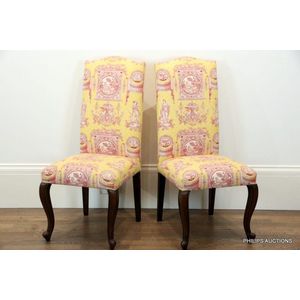Toile-covered high back dining chairs in French style
A set of six toile covered high back dining chairs in the French manner, camel hump chairs with upholstered backs and stuffover seats, covered in a striking cherry and yellow neoclassical pattern cotton toile, raised on cabriole legs with whorl ends, tapered legs to the rear, height 105 cm, width 48 cm, depth 60 cm
You must be a subscriber, and be logged in to view price and dealer details.
Subscribe Now to view actual auction price for this item
When you subscribe, you have the option of setting the currency in which to display prices to $Au, $US, $NZ or Stg.
This item has been sold, and the description, image and price are for reference purposes only.
- Cabriole Leg - The cabriole leg evolved from an elongated scroll, curving out at the knee which may or may not be carved, and forming a serpentine shape as it descends to the foot.
First introduced into English furniture in the late 17th century, cabriole legs were widely used during the Queen Anne and early Georgian periods, where they frequently terminated in a pad foot or ball and claw foot. The style has had many imitators since then. The cabriole leg was re-introduced in the mid-19th century, and is commonly associated with the balloon-back dining or drawing-room chairs made in walnut, mahogany or, in Australia, cedar. The Victorian cabriole leg, on the whole, was rather more slender than the earlier form, following the French style, which emphasized the delicacy and daintiness of the chairs they were designed to support. Cabriole legs are sometimes found on windsor chairs, especially those made during the 18th century. - Tapered Legs - found on both cabinet and country-made furniture from the 18th to the later 19th centuries. The leg sometimes terminates in a spade foot, though on most country furniture the taper continues for the whole length of the leg. The important thing to remember is that the taper ought only to be on the inside face of the leg, and the outer face should be straight and square. Some legs were made where both sides tapered, but in such a case the taper ought to be the same on both the inner and outer faces of the leg. Where the inside of a leg is straight, with only the outer face tapering, there is every reason to be suspicious
This item has been included into following indexes:
